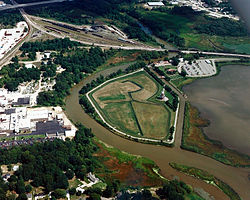Windmill Island Gardens today
The park includes approximately 36 acres (15 ha) of land along the Macatawa River and the swamp leading into Lake Macatawa.
Each year Windmill Island Gardens hosts approximately 55,000 tourists. The park is open daily from late April until early October, with the most visitors in early May during the Tulip Time Festival. Over 100,000 tulips are planted on the island each year in beautiful gardens filled with flowers summer through autumn. In addition to the windmill, the park includes replicas of several historic buildings in the Netherlands. In the summer months, visitors may also see the klompen dance, traditionally performed by local high school students during the annual Tulip Time Festival.
After Tulip Time season, tourists continue to enjoy the Island's attractions, and the park frequently hosts weddings and events. The Island's celebration pavilion can seat up to 300 people. Wedding ceremonies are typically held outside the park or in the Island's gardens, with receptions and banquets taking place in the pavilion.
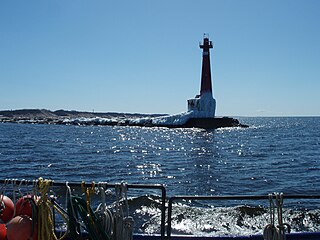
Muskegon is a city in the U.S. state of Michigan. It is the county seat of Muskegon County. Muskegon is known for fishing, sailing regattas, pleasure boating, and as a commercial and cruise ship port. It is a popular vacation destination because of the expansive freshwater beaches, historic architecture, and public art collection. It is the most populous city along the western shore of Michigan. At the 2020 census the city population was 38,318. It is at the southwest corner of Muskegon Township, but is administratively autonomous.

Lisse is a town and municipality in the province of South Holland in the Western Netherlands. The municipality, which lies within the Duin- en Bollenstreek, covers an area of 16.05 km2 (6.20 sq mi) of which 0.36 km2 (0.14 sq mi) is water. Its population was 22,800 in 2019. Located within the municipal boundary is also the community De Engel.

Holland is a city in the western region of the Lower Peninsula of the U.S. state of Michigan. It is situated near the eastern shore of Lake Michigan on Lake Macatawa, which is fed by the Macatawa River.

The Netherlands Carillon is a 127-foot (39-m) tall campanile housing a 53-bell carillon. The instrument and tower were given in the 1950s "From the People of the Netherlands to the People of the United States of America" to thank the United States for its contributions to the liberation of the Netherlands from Nazi Germany in 1945 and for its economic aid in the years after. The Netherlands Carillon is a historic property listed on the National Register of Historic Places as part of Arlington Ridge Park, which is part of the George Washington Memorial Parkway. It is owned and operated by the National Park Service. The carillon is situated on a ridge overlooking the Potomac River and Washington, DC, and it provides expansive views of the National Mall, West Potomac Park, and Arlington National Cemetery. Its adjacency to the Marine Corps War Memorial to the north and Arlington National Cemetery to the south draws 1.2 million visitors annually, including recreational visitors from Rosslyn's residential areas. Throughout the day, the carillon automatically plays the Westminster Quarters. On significant days of the year in Dutch and American culture, it plays automated concerts, and from June to August, the director-carillonist Edward Nassor hosts a concert series whereby visiting carillonists perform weekly concerts on the instrument.

Tulip Time Festival is an annual festival held in Holland, Michigan. Tulip festivals are held in many cities around the United States of America that were founded or largely inhabited by Dutch settlers. It has been held every year in mid-May since 1929 and is currently the largest tulip festival in the United States. The festival currently runs from the first Saturday in May through the second Sunday.

Tulip festivals are held in several cities around the world, mostly in North America, usually in cities with a Dutch heritage such as Albany, New York, Ottawa, Ontario; Gatineau, Quebec; Montreal, Quebec; Holland, Michigan; Lehi, Utah; Orange City, Iowa; Pella, Iowa; Mount Vernon, Washington; and Woodburn, Oregon, and in other countries such as New Zealand, Australia, India, and England. The tulips are considered a welcome harbinger of spring, and a tulip festival permits residents to see them at their best advantage. The festivals are also popular tourist attractions. The tulips are displayed throughout the cities. In certain years the peak of tulips does not coincide with the actual festival due to climatic conditions.

West Michigan and Western Michigan are terms for an arbitrary region in the U.S. state of Michigan's Lower Peninsula. Most narrowly it refers to the Grand Rapids-Muskegon-Holland area, or more broadly to most of the region along the Lake Michigan shoreline of the Lower Peninsula, but there is no official definition for it.

The Canadian Tulip Festival is a tulip festival, held annually in May in Ottawa, Ontario, Canada. The festival claims to be the world's largest tulip festival, displaying over one million tulips, with attendance of over 650,000 visitors annually. Large displays of tulips are planted throughout the city, and the largest display of tulips is found in Commissioners Park on the shores of Dow's Lake, and along the Rideau Canal with 300,000 tulips planted there alone.

Keukenhof, also known as the Garden of Europe, is one of the world's largest flower gardens, situated in the municipality of Lisse, in the Netherlands. According to the official website, Keukenhof Park covers an area of 32 hectares and approximately 7 million flower bulbs are planted in the gardens annually. Keukenhof is widely known for its tulips, it also features numerous other flowers, including hyacinths, daffodils, lilies, roses, carnations and irises.
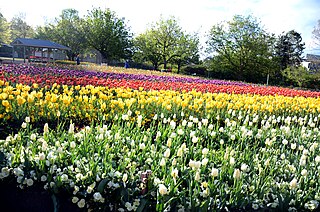
Floriade is a flower and entertainment festival held annually in Canberra's Commonwealth Park featuring extensive displays of flowering bulbs with integrated sculptures and other artistic features. Floriade comes from the Latin word floriat, which means to design with flowers.
Dutch Americans are Americans of Dutch descent whose ancestors came from the Netherlands in the recent or distant past. Dutch settlement in the Americas started in 1613 with New Amsterdam, which was exchanged with the English for Suriname at the Treaty of Breda (1667) and renamed to New York City. The English split the Dutch colony of New Netherland into two pieces, and named them New York and New Jersey. Further waves of immigration occurred in the 19th and 20th centuries.
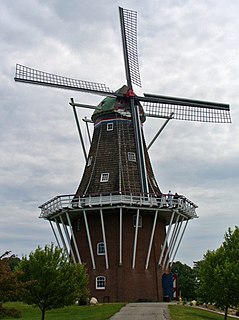
De Zwaan is an authentic Dutch windmill in the city of Holland, Michigan. The windmill's name is Dutch for The Swan or Graceful Bird. It is the oldest authentic, working Dutch windmill in the United States. De Zwaan is located in Windmill Island municipal park.

Holland State Park is a public recreation area covering 142 acres (57 ha) in Park Township, Ottawa County, four miles (6 km) west of the city of Holland, Michigan. The state park consists of separate Lake Macatawa and Lake Michigan units on the northern side of the channel connecting Lake Macatawa with Lake Michigan. It is often the most visited state park in Michigan, receiving between 1.5 and 2 million visitors annually.

The Royal Flora Ratchaphruek was an international horticultural exposition held 1 November 2006 to 31 January 2007 in the Thai city Chiang Mai of Chiang Mai Province that drew 3,781,624 visitors. Recognised by the Bureau International des Expositions (BIE), it was one of the grand celebrations hosted by the Royal Thai Government in honor of King Bhumibol, the world's longest reigning monarch.
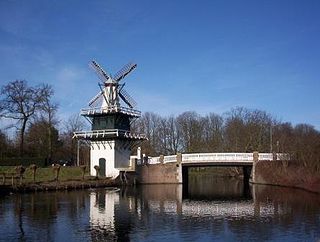
Groenendaal park lies at the center of Heemstede, Netherlands. The park includes the grounds of old Heemstede country estates Bosbeek, and Meer en Berg. Along its western borders are the old Heemstede country estates Hartekamp, Huis te Manpad, and Iepenrode. On the eastern boundary is the city cemetery.

The Duin- en Bollenstreek is a region in the Western Netherlands, that features coastal dunes and the cultivation of flower bulbs. Situated at the heart of historical Holland nearby the city of Leiden, South Holland, it is boundered by The Hague to the west and Haarlem to the north. The combination of beaches, flower fields, lakes and history makes this area attractive to tourists.
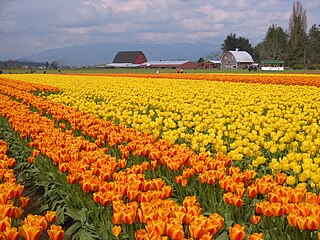
The Skagit Valley Tulip Festival is a tulip festival in the Skagit Valley of Washington state, United States. It is held annually in the spring, April 1 to April 30.

Dutch Michiganders are residents of the state of Michigan who are of Dutch ancestry. In the 1840s, Calvinist immigrants desiring more religious freedom immigrated. West Michigan in particular has become associated with Dutch American culture, and the highly conservative influence of the Dutch Reformed Church, centering on the cities of Holland and Grand Rapids. Dutch is still spoken by the elderly and their children in Western Michigan. As of 2010, 5.1% of Michiganders are of Dutch descent.
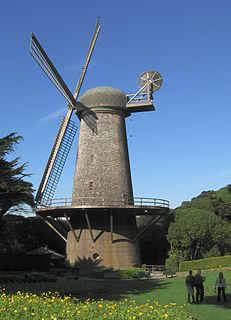
The Dutch Windmill is the northern of two functioning windmills, the other being Murphy Windmill, on the western edge of Golden Gate Park in San Francisco, California. It was completed in 1903, and placed on the San Francisco Designated Landmark list on December 6, 1981.
